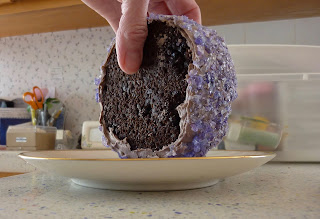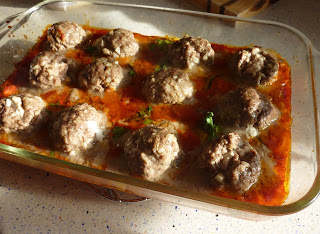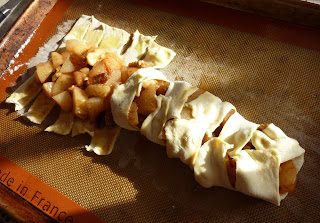I went through three cookbooks to come up with this recipe: the Garde Manger, Food in Jars, and the Ball Book. The textbook was not a canning recipe, because it's generally not legal for restaurants to serve home-canned foods. It did use part red wine vinegar as an acid ingredient, which is what I was looking for in the textbook. The important part is that the vinegar(s) used contain at least 5% acidity by volume. The other two books provided the correct proportions and methods for safe canning.
I'm going to warn you now, ketchup takes a long time. This is 1/8 the recipe in the Ball book by pounds of tomatoes, because I was trying to make roughly the same amount as a good-sized bottle from the store. Reducing it to the desired consistency took almost an hour. If I had done anywhere near the 24 pounds of tomatoes in the full recipe, it would have taken 4-6 hours.
Warning #2, this doesn't save you any money unless you grew the tomatoes yourself. The cheapest I ever see Romas at the peak season is 98¢ a pound. With the other ingredients, that's close to $4 per pint. The bottled Passover ketchup costs less than that. It's a lot more tomatoes than you think, about a dozen of the big ones at the market. You can change to a different kind of tomato, but the water content will differ and alter your yield.
If you're not process-canning your ketchup, you can reduce the amount of vinegar to make it less acidic, or change the amount of sugar and salt. These are the proportions for safe canning. You do have to finish the ketchup within a couple of weeks in the fridge, so bear that in mind before making a huge batch that you don't plan to process. There aren't any notes in the Ball book about freezing failed seals. My best guess is that it would separate upon defrosting.- *3/4 tsp celery seed
- *1/2 tsp whole cloves
- *1" piece of stick cinnamon
- 1/4 tsp allspice berries
- 1/3 C + 1Tb vinegars (any combination of apple cider, red wine, and balsamic if you want an extra kick)
- 3 lbs Roma tomatoes, cored and quartered
- 1/3 C finely chopped onion or *5 tsp dried onion flakes, crushed
- 1/8 tsp cayenne pepper (I used chili powder instead for a smoky flavor)
- 1/3 C sugar
- 1/2 Tb salt
1. Place celery seed, cloves, cinnamon, and allspice in a cheesecloth bag or stainless steel tea strainer. Place in a non-reactive saucepan with the vinegars. Bring to a boil. Remove from heat and allow to steep while you start to cook the tomatoes.
2. In a large, non-reactive saucepan, combine tomatoes, onions, and cayenne. Bring to a boil over high heat, stirring frequently. Reduce heat and boil gently for 20 minutes.3. Remove the spice container from the vinegar and discard. Add infused vinegar to the tomatoes and boil gently until vegetables are soft and mixture begins to thicken, about 30 minutes.4. Working in batches, transfer mixture to a sieve placed over a glass or stainless bowl and press with the back of a spoon to extract all the liquid. If you have a food mill, use the finest plate and be glad it will be easier to clean than the strainer. Discard solids.5. Return the liquid to the saucepan. (And yes, I'm aware this is a different pot.) Add sugar and salt. Bring to a boil over medium heat, stirring occasionally. Reduce heat and boil gently, stirring frequently to avoid scorching, until volume is reduced by half and mixture is similar to commercial ketchup, about 45 minutes. It's still going to have more of the texture of thick tomato sauce, not perfectly smooth like what you buy.6. If canning, use the reduction time to prepare your canner, jars, and lids for a 1 pint to 1-1/4 pint yield. It will depend on how far you reduce and how well you strained the juices. Ladle hot ketchup into hot jars, leaving 1/2" headspace. This is one of those products that can possibly siphon. Remove air bubbles, adjust headspace, wipe rims, center lids, screw on bands finger-tight. Process for 15 minutes once canner returns to a boil. Remove lid once time is reached and allow to sit 5 minutes before removing from the canner. Cool jars, test lids, wipe, and store in a cool, dry place.
6a. If not canning, allow ketchup to cool until no longer steaming. Store in a non-reactive container in the fridge, leaving the lid cracked until product is completely cooled. Use within 2-3 weeks. (Same with opened processed jars.)
Makes about 1 pint
Difficulty rating :-0












































